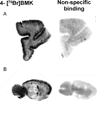[(76) Br]BMK-152, a nonpeptide analogue, with high affinity and low nonspecific binding for the corticotropin-releasing factor type 1 receptor
- PMID: 21308801
- PMCID: PMC3625961
- DOI: 10.1002/syn.20919
[(76) Br]BMK-152, a nonpeptide analogue, with high affinity and low nonspecific binding for the corticotropin-releasing factor type 1 receptor
Abstract
Corticotropin-releasing factor (CRF), a neuropeptide, regulates endocrine and autonomic responses to stress through G-protein coupled receptors, CRF(1) or CRF(2) . A PET ligand able to monitor changes in CRF(1) receptor occupancy in vivo would aid in understanding the pathophysiology of stress-related diseases as well as in the clinical development of nonpeptide antagonists with therapeutic value. We have radiolabeled the CRF(1) receptor ligand, [8-(4-bromo-2,6-dimethoxyphenyl)-2,7-dimethylpyrazolo[1,5-α][1,3,5]triazin-4-yl]-N,N-bis-(2-methoxyethyl)amine (BMK-152) (ClogP = 2.6), at both the 3 and 4 position with [(76) Br]. Using in vitro autoradiography saturation studies the 4-[(76) Br]BMK-152 exhibited high affinity binding to both rat (K(d) = 0.23 ± 0.07 nM; n = 3) and monkey frontal cortex (K(d) = 0.31 ± 0.08 nM; n = 3) consistent with CRF(1) receptor regional distribution whereas with the 3-[(76) Br]BMK-152, the K(d) s could not be determined due to high nonspecific binding. In vitro autoradiography competition studies using [(125) I]Tyr(0) -o-CRF confirmed that 3-Br-BMK-152 (K(i) = 24.4 ± 4.9 nM; n = 3) had lower affinity (70-fold) than 4-Br-BMK-152 (K(i) = 0.35 ± 0.07 nM; n = 3) in monkey frontal cortex and similiar studies using [(125) I]Sauvagine confirmed CRF(1) receptor selectivity. In vivo studies with P-glycoprotein (PGP) knockout mice (KO) and their wild-type littermates (WT) showed that the brain uptake of 3-[(76) Br]BMK/4-[(76) Br]BMK was increased less than twofold in KO versus WT indicating that 3-[(76) Br]BMK-152/4-[(76) Br]BMK was not a Pgp substrate. Rat brain uptakes of 4-[(76) Br] BMK-152 from ex vivo autoradiography studies showed regional localization consistent with known published CRF(1) receptor distribution and potential as a PET ligand for in vivo imaging of CRF(1) receptors.
Copyright © 2011 Wiley-Liss, Inc.
Figures






Similar articles
-
Distribution of corticotropin-releasing factor (CRF) receptor binding in the mouse brain using a new, high-affinity radioligand, [125 I]-PD-Sauvagine.J Comp Neurol. 2017 Dec 15;525(18):3840-3864. doi: 10.1002/cne.24307. Epub 2017 Sep 13. J Comp Neurol. 2017. PMID: 28842924
-
Ligand affinity for amino-terminal and juxtamembrane domains of the corticotropin releasing factor type I receptor: regulation by G-protein and nonpeptide antagonists.Biochemistry. 2004 Apr 6;43(13):3996-4011. doi: 10.1021/bi036110a. Biochemistry. 2004. PMID: 15049707
-
Receptor occupancy of nonpeptide corticotropin-releasing factor 1 antagonist DMP696: correlation with drug exposure and anxiolytic efficacy.J Pharmacol Exp Ther. 2003 Apr;305(1):86-96. doi: 10.1124/jpet.102.045914. J Pharmacol Exp Ther. 2003. PMID: 12649356
-
Recent advances with the CRF1 receptor: design of small molecule inhibitors, receptor subtypes and clinical indications.Curr Pharm Des. 1999 May;5(5):289-315. Curr Pharm Des. 1999. PMID: 10213797 Review.
-
Corticotropin-releasing factor (CRF) and endocrine responses to stress: CRF receptors, binding protein, and related peptides.Proc Soc Exp Biol Med. 1997 May;215(1):1-10. doi: 10.3181/00379727-215-44108. Proc Soc Exp Biol Med. 1997. PMID: 9142133 Review.
Cited by
-
Comparison of Prostate-Specific Membrane Antigen Expression Levels in Human Salivary Glands to Non-Human Primates and Rodents.Cancer Biother Radiopharm. 2020 May;35(4):284-291. doi: 10.1089/cbr.2019.3079. Epub 2020 Feb 19. Cancer Biother Radiopharm. 2020. PMID: 32074455 Free PMC article.
-
Corticotropin releasing hormone and imaging, rethinking the stress axis.Nucl Med Biol. 2015 Apr;42(4):323-39. doi: 10.1016/j.nucmedbio.2014.11.008. Epub 2014 Nov 26. Nucl Med Biol. 2015. PMID: 25573209 Free PMC article. Review.
-
Structure-based drug discovery of a corticotropin-releasing hormone receptor 1 antagonist using an X-ray free-electron laser.Exp Mol Med. 2023 Sep;55(9):2039-2050. doi: 10.1038/s12276-023-01082-1. Epub 2023 Sep 1. Exp Mol Med. 2023. PMID: 37653040 Free PMC article.
-
Microwave-Assisted Synthesis, Structure, and Preliminary Biological Evaluation of Novel 6-Methoxy-5,6-dihydro-5-azapurines.ACS Omega. 2023 Apr 5;8(15):14097-14112. doi: 10.1021/acsomega.3c00765. eCollection 2023 Apr 18. ACS Omega. 2023. PMID: 37091407 Free PMC article.
-
Orphan neuropeptides and receptors: Novel therapeutic targets.Pharmacol Ther. 2018 May;185:26-33. doi: 10.1016/j.pharmthera.2017.11.006. Epub 2017 Nov 22. Pharmacol Ther. 2018. PMID: 29174650 Free PMC article. Review.
References
-
- Altholtz LY, Fowler KA, Badura LL, Kovacs MS. Comparison of the stress response in rats to repeated isoflurane or CO2:O2 anesthesia used for restraint during serial blood collection via the jugular vein. J Am Assoc Lab Anim Sci. 2006;45(3):17–22. - PubMed
-
- Arborelius L, Owens MJ, Plotsky PM, Nemeroff CB. The role of corticotropin-releasing factor in depression and anxiety disorders. J Endocrinol. 1999;160(1):1–12. - PubMed
MeSH terms
Substances
Grants and funding
LinkOut - more resources
Full Text Sources
Research Materials
Miscellaneous
